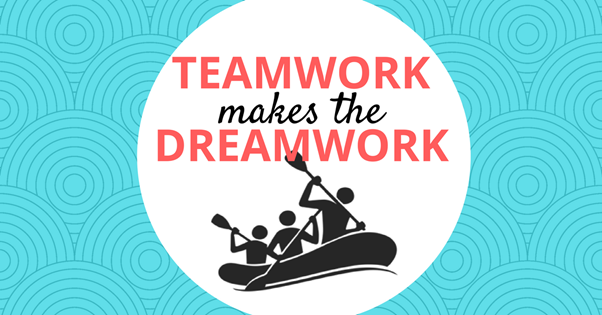I was delivering a team building workshop not so long ago to a group of leaders and we got into a little bit of a debate.
I was encouraging them to lead by example and create a team environment by encouraging and including ideas and input. During the debate one of the delegates said, “Oh for goodness’ sake, this is all about the Gen X and their entitlement, they honestly think we live in a democracy!”, I replied with “No, I believe that we must encourage an environment where we promote to old, there is no “I” in team”. The delegate said that they tried saying this but were met with “Ah yes… but there is an M and E in team…”
So, how can we promote Teamwork among Employees?… Well, consistency is one way, and we also need to make sure that we are not just talking the talk but… Well, you know the rest of this saying…
Tips to promote Teamwork among Employees
Teamwork is a critical element of a successful and productive workplace. When employees work together, it creates a positive work environment where more can be achieved.
The following suggestions are posed under the assumption that you already have the right people in each position on your team. The foundation of teamwork depends on hiring the right people and effective leadership. When teams work well together, an efficient workplace culture with problem solving abilities, inspiration and support is achieved. Being in an environment that works toward shared goals will empower employees and create a sense of belonging.
As a manager, it’s your responsibility to encourage teamwork among your employees. You will need to provide your team with the tools and guidance they need to reach their full potential. Here are 20 effective ways managers can promote teamwork in their teams.
Lead by Example
Set the tone for teamwork by demonstrating the behaviour and positive attitude towards working with others that you want to see from your team.
Your team pay a lot of attention to what you say and do. If you say one thing but do another, it can lead your team to feelings of frustration and mistrust.
Outline Roles and Responsibilities
It’s more common than you would think for a team member to be unclear on their role and responsibilities.
Every team member should have a comprehensive understanding of their role and what is expected of them within the team to minimise confusion and overlap.
Encourage Open Communication
Create an environment where employees feel comfortable sharing:
- Ideas
- Concerns
- Feedback with their teammates
Foster Trust
It’s so important to build trust among team members in order to promote teamwork.
Encourage honesty and reliability to establish a strong foundation.

Establish Common Goals
Align your team around shared objectives, making it easier for everyone to work together towards a common purpose.
Common team goals provide structure that allows you to measure progress of individuals and the group as a whole.
Training and Development
Staff Retention rates rise by 30-50% in companies with strong learning cultures.
Improve your employees’ skills and knowledge by investing in their professional development. Staff who do not receive training typically produce less work and at a lower quality.
Celebrate Achievements
Acknowledge and reward both individual and team achievements to boost morale and motivation.
Celebrating success reinforces the motivation that will bring us to the next achievement.
Clear Expectations
Ensure everyone knows what is expected of them and the team.
This includes:
- Deadlines
- Performance metrics
- Accountability
- Flexibility
Inclusivity
Encourage diversity and inclusion, valuing the unique perspectives and contributions of each team member.
Inclusion in the workplace creates a sense of belonging that can lead to greater productivity and teamwork.
Team-Building Activities
Organise team-building exercises, workshops, or outings to help team members bond and build trust.
Studies have shown that employee satisfaction can increase by up to 50% when surrounded by people they are friendly with.
Provide Necessary Tools and Resources
Ensure your team has access to:
- Technology
- Resources
- Information they need to collaborate effectively.
Offer Flexibility
Allowing some flexibility in work arrangements, when possible, to accommodate personal needs can improve employee satisfaction.
When employees are satisfied with their working arrangements, they are more likely to be productive and engaged, ultimately leading to team-cohesion.
Empower Decision-Making
Encourage team members to participate in decision-making processes, fostering a sense of ownership and responsibility.

Resolve Conflicts Promptly
Addressing conflicts and issues within the team as soon as they arise prevents them from escalating.
A good tip is to ensure your business has a clear grievance-resolution process in place. This can help to avoid conflict in the workplace and prevent any existing conflict among team members from escalating.
Encourage Knowledge Sharing
Create a culture of sharing knowledge and best practices among team members.
Knowledge sharing in the workplace promotes new ideas and innovation.
Regularly Assess Team Performance
Conduct regular performance reviews and team evaluations to identify areas for improvement.
Evaluating team performance allows you to avoid conflicts and misunderstandings, while also identifying areas for improvement, acknowledging achievements, and encouraging learning.
Provide Feedback
Offering constructive feedback can help employees understand how they can contribute more effectively to the team.
Cross-Functional Collaboration
Encourage employees to work with colleagues from other departments to broaden their perspectives and skills. By bringing together various perspectives and knowledge from different departments, businesses can support a more collaborative environment.

Recognise and Address Burnout
Recent reports have found that 52% of all workers are feeling burned out. This is a 9% increase from pre-COVID.
Watch for signs of burnout and provide support to team members who may be overwhelmed.
Some of the signs of employee burnout include:
- Emotional, mental, and physical exhaustion
- Disengagement
- Increased absenteeism
- Higher sensitivity to feedback
- Decreased productivity
Adapt and Evolve
An effective leader is flexible in their approach. They will adapt to changing circumstances and continuously seek ways to improve and promote teamwork.
The more you adapt and evolve, the more relevant you will be in your industry.
Adaptability allows you to overcome obstacles.
Having a team that works effectively together is no easy task. It is an ongoing effort that requires commitment and dedication from business leaders.
Remember, “Hope is not a strategy”. By having a plan, you can create a productive work environment where your team can thrive, achieve their goals, and contribute to the overall success of the business.
Teamwork is not just a “buzzword”, but a vital element of a successful and harmonious workplace.
Contact KONA to discuss how our tailored training programs can add value to
your business.
Call 1300 611 288 or Email info@kona.com.au




























 Many people will certainly have higher sensitivity to germs and the risks of spreading infections. This behaviour alone will change many industries. Customers and workers will be more sceptical of close contact with others. Consumer travel, dining, entertainment and product preferences will be different moving forward. The list of changed behaviours and their impact will surely be long, though still to be formed as COVID-19 runs its course.
The number of behaviour changes will grow depending on how many people are directly affected, how severely and for how long. Many new behaviours will be normalised as customers practice them repeatedly over months.
Many people will certainly have higher sensitivity to germs and the risks of spreading infections. This behaviour alone will change many industries. Customers and workers will be more sceptical of close contact with others. Consumer travel, dining, entertainment and product preferences will be different moving forward. The list of changed behaviours and their impact will surely be long, though still to be formed as COVID-19 runs its course.
The number of behaviour changes will grow depending on how many people are directly affected, how severely and for how long. Many new behaviours will be normalised as customers practice them repeatedly over months.
 Many customer behaviour changes will require new or modified products and services. New market leaders will emerge while some past leaders fade. Many companies will struggle post COVID-19.
Many customer behaviour changes will require new or modified products and services. New market leaders will emerge while some past leaders fade. Many companies will struggle post COVID-19.

 Understanding what your customers will value in the post-COVID-19 business world and acting on it will ensure your survival and success and put you ahead of major competitors.
These points cannot be over-emphasised – knowing the customer will sort the post-COVID-19 business winners from the competition.
Understanding what your customers will value in the post-COVID-19 business world and acting on it will ensure your survival and success and put you ahead of major competitors.
These points cannot be over-emphasised – knowing the customer will sort the post-COVID-19 business winners from the competition.







































































